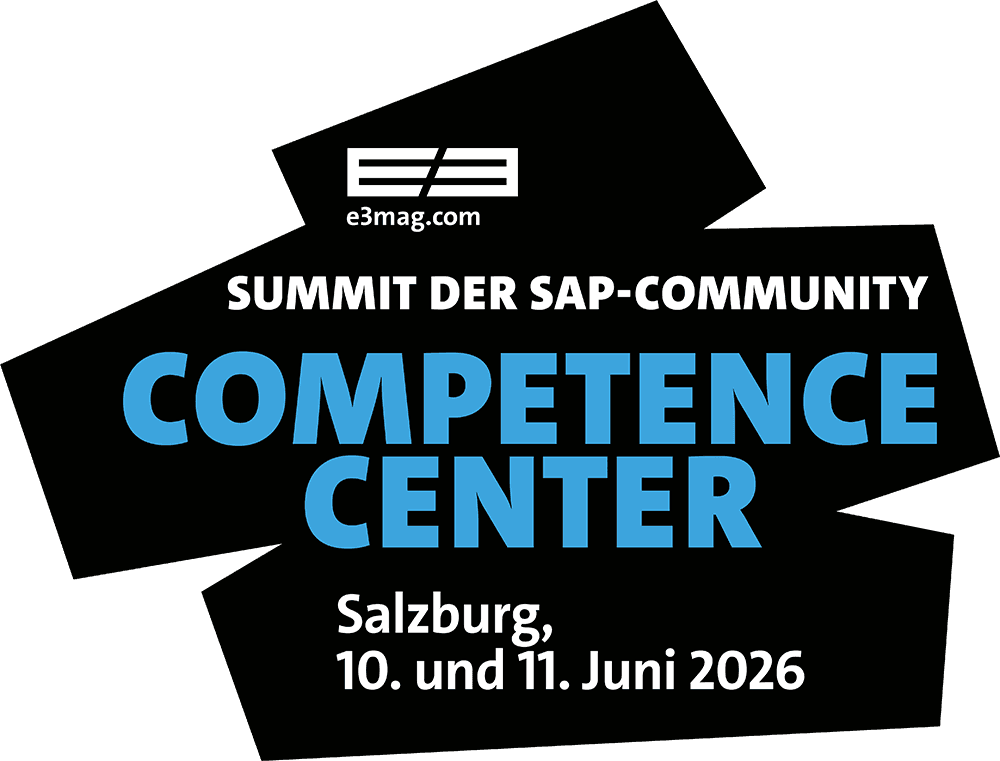Freedom for Data


SAP customers are confronted with the topic of data management and archiving right from the start of their ERP journey. The comprehensive topic of master data management is the responsibility of every SAP manager. Since its foundation, SAP itself has always moved between the two poles of algorithms and data structures.
For many years, the focus was on business processes and SAP also became the ERP world market leader because no other IT company had as many answers to the management of business organizational structures and processes. Even if the focus was often on end-to-end business processes, the philosophy of the computer science standard work "Algorithms and Data Structures" by the late ETH Zurich professor Niklaus Wirth was always there in the background. Both are needed: data management and business processes.
SAP itself was late to devote itself to a structured approach to the topic of data. Of course, suitable archiving solutions were available early on and many older members of the SAP community will still remember the intensive cooperation between the IT company Ixos and SAP at the time. Strategic data communication and management was first introduced at SAP with the middleware and platform product NetWeaver. This was followed by numerous other products and cloud platforms such as SAP Data Hub, HEC (Hana Enterprise Cloud), SAC (SAP Analytics Cloud), Datasphere and SAP BTP (Business Technology Platform). At the beginning of 2025, SAP presented Business Data Cloud (BDC) as the preliminary high point and end point.
According to the German-speaking SAP user association DSAG, SAP is aiming for cross-system harmonization of SAP data management with BDC. This new solution will in turn access various sub-solutions, such as SAP Analytics Cloud (SAC), Datasphere, SAP Business Warehouse and BW/4 Hana in the S/4 Private Cloud Edition. "The Business Data Fabric is at the heart of SAP BDC. This is where the data is semantically processed and made available in a standardized way. The data used can come from the connected eco-system - either directly from all SAP applications or already prepared via existing business warehouse systems," explains Sebastian Westphal, DSAG Chief Technology Officer. The data available in the BDC can then be used with AI from SAP or 3rd party providers.
SAP partner DMI organized its own networking event including a hackathon during the World Economic Forum (WEF 2025) under the leadership of founder and CEO Thomas Failer. "The motto of the WEF 2025 was Collaboration for the Intelligent Age," reports DMI CEO Thomas Failer in an exclusive interview with E3. "Unfortunately, this motto was somewhat lost in the excitement surrounding Donald Trump's inauguration. But I think it really is the topic of our time. How do we work together as companies and entrepreneurs to become more productive and independent with the help of AI in a world characterized by great uncertainty and unpredictability in order to react flexibly to all changes, perhaps even anticipate them and remain productive and successful in the long term? This also applies to me personally as an entrepreneur. It is my responsibility to ensure that my success is also the success of my employees and my social environment."

Via the application layer to S/4
The WEF is an important but short event and access is very limited. "With our hackathon, we offered talents not only from German-speaking countries, but also from Algeria, Dubai or the USA the opportunity to come to Davos, solve interesting tasks and even get to know potential future employers," says Thomas Failer, defining his personal motivation for the DMI hackathon. "The solutions that the teams developed in just 36 hours are extraordinary." (See also JiVS Hackathon Davos 2025: AI that serves people and companies)
Thomas Failer explains the task set by DMI as part of the JiVS Hackathon Davos 2025 as follows: "We recommend using the application layer for the transformation to S/4 because we believe it is the risk-free and least error-prone method. However, this also means that business objects are available for all data that is to be transferred to the new system. Identifying, designing and finally implementing the necessary objects - apart from the standard objects that already exist in S/4, of course - takes time and requires a great deal of specialist knowledge. Automating this process using AI was one of the two tasks we set, and this was solved with flying colors. The users formulate their problem in natural language via chatbot and the AI makes suggestions as to which data from which objects is useful."
Making the most of corporate AI
With the new Business Data Cloud, SAP wants to present a solution that can bring together all SAP and third-party data in a company. "SAP Business Data Cloud makes it possible to leverage business data for enterprise AI," said Christian Klein, CEO of SAP SE. "The groundbreaking solution combines SAP's unparalleled expertise in business-critical, end-to-end processes and data with rich semantics with Databricks' outstanding data engineering expertise. This helps companies get even more out of their data." Many existing SAP customers want to get more value from their data and AI investments.

Christian Klein, CEO, SAP
The solution provides managed SAP data products for business processes - from financial, spend and supply chain data in SAP S/4 Hana and SAP Ariba to training and employee data in SAP SuccessFactors solutions. The original business context and semantics are retained in these data products. BDC will also provide so-called insight apps as an innovation. These use data products and AI models that use real-time data. Complex evaluations and information enable planning in all business areas, including for central business analyses or in finance and human resources.
"Users want more and more ease of use and to query company data independently of business objects," says DMI boss Thomas Failer. "Not as SQL statements, of course, but in natural language. Our hackathon team in Davos succeeded in developing a corresponding AI-supported chatbot, which was sensational." "The SAP Business Data Cloud lays important foundations for the future," explained Sebastian Westphal in a DSAG statement, adding: "It can help our 4,000 member companies to make better use of their SAP data - especially for Business AI scenarios." Provided that SAP consistently implements the announcements, DSAG believes that the BDC will enable progress in process automation, planning and innovation. As an integration layer, it could also facilitate data exchange with data warehouse and analytics platforms - even across hyperscalers thanks to Databricks functionalities.
It's not just about Gen AI
Thomas Failer sees the relevance of AI in the corporate context primarily in three areas, which can certainly be combined: "Firstly, AI has enormous potential for automation, which ideally translates into real leaps in productivity. This is not primarily about generative AI, but any form of it, machine learning algorithms as well as fuzzy logic. The second area is what has traditionally been referred to as knowledge management. Here, it is primarily generative AI that brings benefits. This is because users no longer need to be experts in a particular field in order to retrieve the knowledge required to solve a specific problem. The third area, which is closely linked to the second, is ease of use, which can be taken to a whole new level using AI." AI helps: In a transformation project, business users can make up for their lack of programming skills. They use their knowledge and enter the requirements for a business object in natural language via an AI-supported chatbot. It converts the request into a suitable SQL statement in the background and queries the data required for a business object.
"This dimension of knowledge management and ease of use will become increasingly important as the search for talent becomes more difficult due to demographic change," Thomas Failer knows from his own experience. "Enjoying and working productively with the tools provided by an employer will be an increasingly important means of finding and retaining talent. I am convinced of this. Attractive employers are thus making themselves a good deal more independent of an increasingly scarce supply of labor."
DMI CEO Failer summarizes his personal experience as follows: "I come from Lake Constance and now live in Davos. Both areas are extremely popular vacation destinations due to their quality of life. But you can't make a living from tourism alone. As an entrepreneur, I see it as my responsibility to provide attractive jobs in my home region. In this way, I can also inspire young talents who would otherwise have moved to the well-known business centers such as Zurich and Geneva or Munich and Stuttgart. That's why our hackathons are so important. It is absolutely fascinating to see how young developers create solutions in one or two days that even long-time professionals would have struggled with. We have already adopted several of the ideas and approaches presented in our product development and have also gained new employees, real AI cracks who are now happy to live in the so-called provinces."
DMI has halved the average duration of transformation projects with its own JiVS product approach. But that cannot and must not be the end of the story, says Thomas Failer. The goal is transformation on demand or at the push of a button. At JiVS, this basically applies to everything: the inventory of a system landscape, an analysis of how much the amount of data to be transferred can be reduced, the separation of data stocks when selling a subsidiary or business unit and the aforementioned design of a new business object. It must be possible to trigger all of these scenarios using natural language input and have them completed in a highly automated manner. "In my view, independence is currently the major strategic goal of IT," emphasizes Thomas Failer emphatically in the E3 discussion, "at all levels, both business and technical. Independent of the life cycle of the applications, independent of the strategy and offerings in the public cloud, independent of regulations, independent of geopolitical changes. The result of this independence is more flexibility and freedom for decision-makers."
Decoupling the data level from the application level and managing the respective lifecycles independently of each other is the DMI key to this comprehensive independence. "The treasure of companies lies in their information, in their data, documents, design drawings, construction plans, contracts, etc.," says Thomas Failer. This treasure is long-lasting and its value can be further increased through intelligent analyses and AI. The top priority for IT must therefore be to ensure that companies are in control of their wealth of information at all times and can make decisions about it freely. This information can also create almost insurmountable dependencies due to its integration with applications and its inclusion in the formats and technologies of certain providers, whether on-premises or in the cloud. In this context, the term vendor lock-in is appropriate.
"We all know how easy it is to move data to the public cloud. And how time-consuming and costly it is to get it back," says DMI CEO Failer, describing the challenge of avoiding a vendor lock-in. This is one of the main reasons for the EU Data Act. This is intended to lower the hurdles. Another example is the transformation to S/4 Hana. There are always new generations of applications. And the more innovative the providers, the more frequently such generational changes occur. This applies equally to all business applications. "We store the companies' information in modern, neutral formats, documents such as payslips as PDF files, for example, or CAD drawings as 3D PDF or TIFF files. There is therefore no interdependence between the structure of the company information on our platform and its functionalities. If our customers wanted to, they could remove their information from our platform at any time and store it elsewhere, but they don't want to," says Thomas Failer, defining the added value of the JiVS DMI platform.
In Asia, there has recently been a requirement for the data that an international company generates in the country regarding employees and business transactions to be physically stored there on a daily basis. "If you operate a central IT environment outside Asia, for example at your own company headquarters or in Europe with a hyperscaler - how do you intend to meet this requirement? How do you filter out the data that is relevant for the location in Asia, and only this data, and replicate it to a storage facility there?" asks Thomas Failer. With the JiVS DMI platform and Replication Services, this should not be a problem. "We transfer the data to our platform on a daily basis, filter out the data that needs to be stored in Asia like a carve-out and transfer it there at top speed," says CEO Failer, explaining the process. Of course, these are not country-specific functionalities. Rather, it is about being able to transfer data precisely and accurately for whatever reason and to react flexibly to new regulations on data storage without having to make complex and expensive changes to your own IT environments every time.
Protecting sensitive data despite AI
The next version of JiVS that DMI will launch on the market will focus on AI functionalities. "Last year, we already talked about the use of AI to identify personal data everywhere - including in documents and other formats such as emails. Now, however, it's not just about identifying data that is particularly worthy of protection. It is much more important to use AI to prevent sensitive data from leaving the company, even if only by mistake. Such data can be personal or fall into the area of business secrets. Incidentally, the results of our hackathon in August last year also play a role here. We were able to recruit two of the developers involved at the time as new employees," says Thomas Failer, describing the requirements of the AI age.
DMI is currently working on a massive improvement in ease of use through AI-supported chatbots, for example to enable the design of business objects in natural language. Another example of the planned AI innovations is the planned Business Objects Proposer. This means that AI will independently analyze data sets and propose new business objects on this basis in order to strengthen the innovative power of companies. This is the goal of the new JiVS generation in the first place: to use AI to increase the degree of automation and boost the speed of innovation. In other words, to fulfill the exact purpose of a managed company-wide data fabric.
With JiVS NG - NG stands for Next Generation - this is possible: there are hardly any more complex documents such as design drawings from CAD systems or construction plans from PDM and PLM systems. JiVS can store these long-term and legally compliant on the DMI platform and ensure access to them from the new systems.

Sebastian Westphal, Chief Technology Officer, DSAG
This involves documents that have a lifespan of up to fifty years. "We are currently working with partners on a solution that enables customers to manage the entire life cycle of PDM data, just as we already do with data," Thomas Failer reports on his current work in the E3 interview. On the one hand, this means the transformation of operational PDM data, but on the other hand, JiVS customers can transform stored documents and/or data on assemblies to the current system at the touch of a button if required. Access to the construction plans of a machine or parts thereof may only become necessary ten or fifteen years after they have been transferred to the JiVS platform. For example, because a system has broken down and needs to be repaired. Only then will it be necessary to know the parts list of the component in question. What needs to be procured again? What is still available? The parts list may need to be revised and updated with new components. "The latter naturally takes place in the new system," explains Thomas Failer, "so the original data has to be transformed. And when everything is together, the workers need the construction plans for repairs.
Instead of transferring all PDM data from the last twenty or thirty years on spec, which would incur unnecessarily high costs, it makes more sense to only carry out the transformation and migration of such long-lived data and documents when required. Automatically and at the touch of a button, so that users don't even notice."
Data-as-a-product philosophy
DSAG supports the introduction of a data-as-a-product philosophy. While SAP has realized an opening for third-party providers in the cloud, the integration of its own products has remained insufficient. From DSAG's point of view, BDC should now close this gap. "The success of BDC could point the way forward for both SAP and user companies - even if the long-term effects and joint product development are still open," says DSAG Chief Technology Officer Sebastian Westphal. For SAP-centric architectures, it is crucial that insight apps deliver business benefits, are cost-efficient and come with low technical hurdles.
DSAG is looking forward to the further roadmap, license models and initial experience reports on implementation. It is a further step in the DMI JiVS strategy to make companies independent of the burden of their legacy data. "Our JiVS platform offers the potential to transfer legacy data from all company applications and manage their lifecycle independently of the original applications. This not only saves you a lot of money, but also makes you less dependent on the fewer providers in this area," summarizes CEO Thomas Failer.






